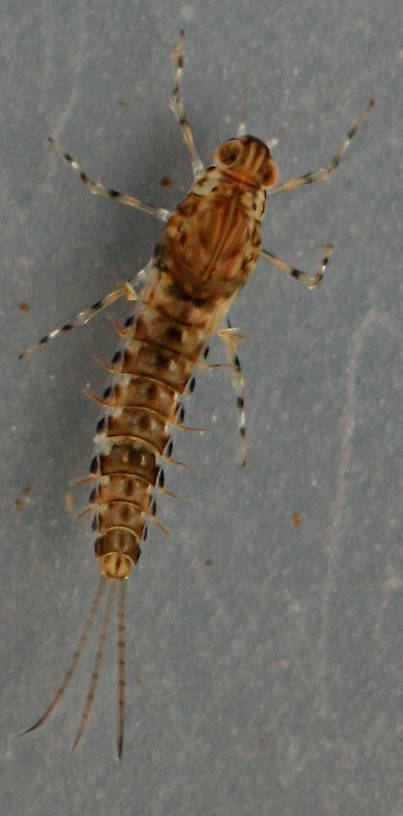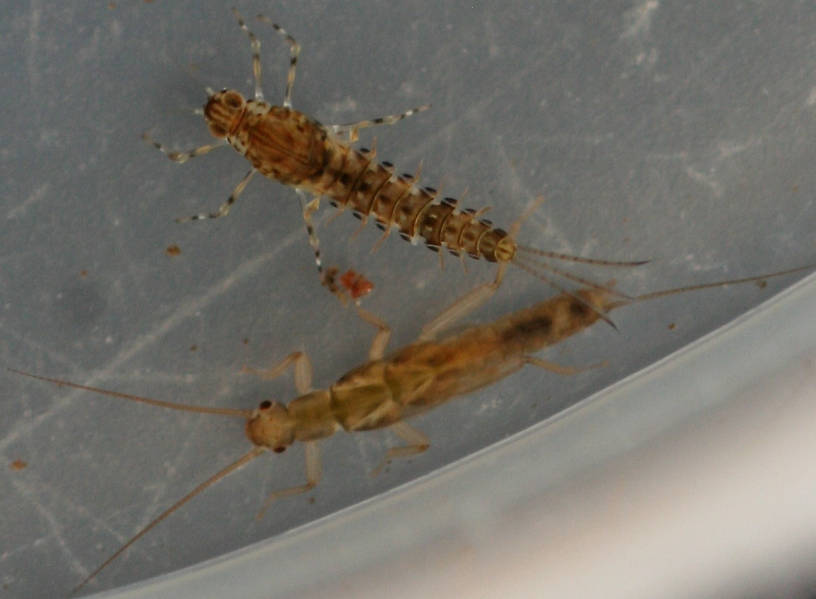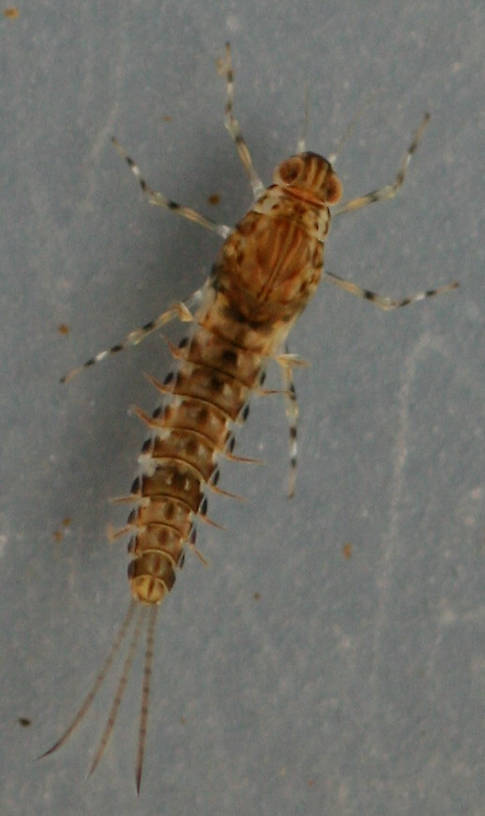Blog & Latest Updates
Fly Fishing Articles
Insects by Common Name


> > Baetid mayfly



| Millcreek | August 24th, 2015, 2:29 pm | |
| Healdsburg, CA Posts: 356 | I found this mayfly on Nov.28, 2014. It was collected in Mill Creek, which is a tributary to the Russian River. It was approximately 7 mm in length, excluding the cerci. Any help identifying it to genus or species would be appreciated. | |
| Entoman | August 24th, 2015, 8:10 pm | |
| Northern CA & ID Posts: 2604 | Hi Mark, I don't think its a baetid. Looks like more like an ameletid to me. | |
| "It's not that I find fishing so important, it's just that I find all other endeavors of Man equally unimportant... And not nearly as much fun!" Robert Traver, Anatomy of a Fisherman | ||
| Millcreek | August 24th, 2015, 9:12 pm | |
| Healdsburg, CA Posts: 356 | Kurt, It didn't have the pectinate spines in the mouthparts. I didn't keep the specimen but I do remember it didn't have those and it did have a notch in the labrum. | |
| Entoman | August 25th, 2015, 12:04 am | |
| Northern CA & ID Posts: 2604 | Ah, shoot... All I have to work with is this photo, and what I can see in it. Without additional visual info of the relevant parts causing the confusion (and if the specimen is lost), there's little else I can help with... Still looks like an ameletid to me, but after all this time enjoying your great (and IMO accurate) submittals, I don't doubt your opinion... I don't know what else to say.:) | |
| "It's not that I find fishing so important, it's just that I find all other endeavors of Man equally unimportant... And not nearly as much fun!" Robert Traver, Anatomy of a Fisherman | ||
| Millcreek | August 25th, 2015, 1:41 am | |
| Healdsburg, CA Posts: 356 | Kurt- Yeah, I knew it was a crap shoot when I put it in but was hoping someone may have found something similar and keyed it out. The photography doesn't help either. Thanks for the try.:) | |
| Entoman | August 25th, 2015, 9:21 pm | |
| Northern CA & ID Posts: 2604 | You're welcome. After a little more thought I do have a little to add. Dichotomous keys can be tricky. Often many of the characters used can be confusing when working with immatures. Either the parts haven't developed enough or some other reason gets in the way. The intensity of the maculation and large size of your specimen is what's bugging me. I think even the largest baetids I'm aware of would be well shy of 7mm at that stage in their development - and certainly not marked that way, among other important differences. | |
| "It's not that I find fishing so important, it's just that I find all other endeavors of Man equally unimportant... And not nearly as much fun!" Robert Traver, Anatomy of a Fisherman | ||
| Millcreek | August 26th, 2015, 11:08 am | |
| Healdsburg, CA Posts: 356 | Dichotomous keys are tricky for immature nymphs. However, ameletids show the pectinated spines in the mouthparts very early in their life, I've found them on nymphs as small as 3mm and they may show on smaller ones. The nymph also doesn't show the large eyes or short antennae of an ameletid. The maculation of the nymph is certainly striking but doesn't preclude a baetid. A number of them are quite striking in color. The size does seem large for a baetid. Anyway, it doesn't seem likely that it will be resolved based on a photo. | |
| Entoman | August 27th, 2015, 3:11 pm | |
| Northern CA & ID Posts: 2604 | Yep, they rarely do. They can make for fun discussions, though. :) In this case, there are some helpful things that are observable. I can't speak to what you observed with the specimen in hand using keys and magnification; nor do I have an explanation for the anomalies between that and what I think I'm seeing. In addition to what has been mentioned earlier I'm seeing the following. 1. The antennae look fairly short to me (about head width or a little longer). Most baetids are usually longer, often around 1/3 to 1/2 body length. 2. Baetids (excepting Callibaetis and the tiny prev. Centroptilium group and a few others) have shorter terminal filaments and they are usually more tapered over their length. These are equal length with most of their taper at the tips. 3. While baetids can have striking dorsal maculation patterns under magnification, they usually look pretty muted in the hand. This specimen looks to be a different order of magnitude, particularly at the lateral margins. However, the legs (particularly the forelegs) look long and spindly for an ameletid. Anyway, interested in your opinions on this. Particularly the terminal filament length and the legs. Perhaps we are missing something? | |
| "It's not that I find fishing so important, it's just that I find all other endeavors of Man equally unimportant... And not nearly as much fun!" Robert Traver, Anatomy of a Fisherman | ||
| Millcreek | August 27th, 2015, 7:23 pm | |
| Healdsburg, CA Posts: 356 | I went back and checked size since this seems a sticking point. I checked it against the size of several stonefly larvae collected at the same time and place. It would measure out at 5.5 to 7 mm. The antennae do seem short although the photo is badly out of focus so it's difficult to say whether they're short or broken off. I really can't remember. I agree pretty much with your other suppositions. I'm beginning to wonder if it could be a Procloeon? I can't find one it matches exactly, but some come pretty close. http://www.discoverlife.org/mp/20q?search=Procloeon | |
| Entoman | August 27th, 2015, 9:02 pm | |
| Northern CA & ID Posts: 2604 | Hmm... You may be on to something, Mark. I was constantly capturing Baetis type nymphs on Fall River in the 5/6 mm range many years ago that were speckled like this. They gave me fits until I captured some that I lucked into nursing into adulthood. They keyed out to genus Centroptilium (now Procloeon*). The nymphs had long skinny legs like a Baetis but the speckled appearance was visible to the naked eye even in those small sizes and the three equal length tails confused me. I'll look for some old photos and put them up for comparison. * Edit - Wrong genus. See post below for explanation. | |
| "It's not that I find fishing so important, it's just that I find all other endeavors of Man equally unimportant... And not nearly as much fun!" Robert Traver, Anatomy of a Fisherman | ||
| Taxon | August 27th, 2015, 9:18 pm | |
Site Editor Royse City, TXPosts: 1350 | Mark- Procloeon or Camelobaetidius are the genera that I eventually came to suspect after having spent considerably more time on your challenge than I am comfortable admitting. :-) | |
| Best regards, Roger Rohrbeck www.FlyfishingEntomology.com | ||
| Entoman | August 27th, 2015, 9:24 pm | |
| Northern CA & ID Posts: 2604 | Uggh! I had my nymphs and duns entered in the encyclopedia under Centroptilium. When I edited for changes in the nomenclature a few years ago, I thought I moved them over to Procloeon. But they appear to be gone gone... Curses! I'll try a few tricks to see if I can locate them floating around the database. Anyway, I believe you are right the more I think about it. Another character worth mentioning is the thicker middle segs of the abdomen as opposed to the straighter taper of the more common baetids. I'll look into it some more now that we've narrowed it down to probable genus and see if I can come up with a species. If I remember correctly, the markings may be of some help. You do the same and let's see what we come up with. :) | |
| "It's not that I find fishing so important, it's just that I find all other endeavors of Man equally unimportant... And not nearly as much fun!" Robert Traver, Anatomy of a Fisherman | ||
| Entoman | August 27th, 2015, 9:29 pm | |
| Northern CA & ID Posts: 2604 | Roger, Thanks for chiming in. Are my lost files on your site perhaps? | |
| "It's not that I find fishing so important, it's just that I find all other endeavors of Man equally unimportant... And not nearly as much fun!" Robert Traver, Anatomy of a Fisherman | ||
| Millcreek | August 27th, 2015, 10:38 pm | |
| Healdsburg, CA Posts: 356 | Roger-Procloeon or Camelobaetidius are the genera that I eventually came to suspect after having spent considerably more time on your challenge than I am comfortable admitting. :-) Glad to hear from you. I spent more time coming up with Procloeon than I'm willing to admit. :) By the way it wasn't Camelobaetdius. Didn't have the denticles. Kurt- I'll be looking forward to pictures and a possible species. Will look myself. | |
| Entoman | August 28th, 2015, 12:05 am | |
| Northern CA & ID Posts: 2604 | Unfortunately, we can't assume Procloeon at this point. I forgot that many of the old spur-wing species (including my Fall R. specimens mentioned above) were also placed in Anafroptilum, so look there as well. My gut tells me that we may find the answer in a diagram from an older paper concerning Centroptilum. It may be worth checking out what Day has to say in Aquatic Insects of CA. I'm at fish camp and don't have access to it. | |
| "It's not that I find fishing so important, it's just that I find all other endeavors of Man equally unimportant... And not nearly as much fun!" Robert Traver, Anatomy of a Fisherman | ||
| Entoman | August 28th, 2015, 1:33 am | |
| Northern CA & ID Posts: 2604 | By a process of elimination based on a few Canadian papers and some older docs descriptions, I'm gonna float A. bifurcatum. Overall body shape, the dark spots on the lateral margins, and lack of a few pale terga contrasted to a few fully dark terga seems to set it apart from the few possibilities remaining that are known to be in that part of the state. Enough fun for one day, I'm going to hit the sack and dream of big fish tomorrow. :) | |
| "It's not that I find fishing so important, it's just that I find all other endeavors of Man equally unimportant... And not nearly as much fun!" Robert Traver, Anatomy of a Fisherman | ||
| Millcreek | August 28th, 2015, 11:04 am | |
| Healdsburg, CA Posts: 356 | A. bifurcatum seems fairly unlikely. See my contribution: http://www.troutnut.com/topic/8568/Anafroptilum-bifurcatum-nymphs-formerly-Centroptilum-bifurcatum as well as Bold systems: http://www.boldsystems.org/index.php/Taxbrowser_Taxonpage?taxid=371223 I suppose it could be a dark version of one but all I've seen are the lighter versions. I plan on looking at Schwiebert's Nymphs later and see what he has to say on the matter. | |
| Konchu | August 31st, 2015, 5:06 pm | |
Site Editor IndianaPosts: 505 | A. conturbatum ? Assuming this is Anafroptilum. Depends if the medial bump is there on abdominal tergum 9. And a few other things, too. :) | |
| Oldredbarn | August 31st, 2015, 6:31 pm | |
| Novi, MI Posts: 2608 | Luke! You are alive! Good to hear from you brother. How goes it these days? Spence | |
| "Even when my best efforts fail it's a satisfying challenge, and that, after all, is the essence of fly fishing." -Chauncy Lively "Envy not the man who lives beside the river, but the man the river flows through." Joseph T Heywood | ||
| Millcreek | August 31st, 2015, 11:31 pm | |
| Healdsburg, CA Posts: 356 | A. conturbatum seems like a long shot. For one thing the coloration seems wrong and the markings as well. Of course the only two pictures I can come up with differ considerably. And they're both preserved and that can change color pretty significantly. http://www.troutnut.com/hatch/185/Mayfly-Centroptilum-Tiny-Sulphur-Duns http://www.boldsystems.org/index.php/Taxbrowser_Taxonpage?taxid=398351 Thing is, they're both different from my specimen. | |
Quick Reply
You have to be logged in to post on the forum. It's this easy:
Related Discussions
| Title | Replies | Last Reply |
| ID on this one? In Male Epeorus Mayfly Dun by Troutnut | 0 | |
| Re: Not Stenacron In Male Maccaffertium modestum Mayfly Dun by GONZO | 2 | Feb 6, 2012 by Brookyman |
| More Baetis nymphs (2 more) In the Identify This! Board by Millcreek | 0 | |
| Re: Hind wings? In Female Procloeon Mayfly Dun by Taxon | 6 | Jul 14, 2011 by Troutnut |
| Re: Scratching my head on the size here... In Male Drunella doddsii Mayfly Dun by Jimspeaker | 1 | May 14, 2022 by Taxon |
| Re: Brown Dun hatch/swarm time? In the Mayfly Species Ameletus ludens by Konchu | 10 | Apr 30, 2009 by Troutnut |
| Re: Gender In Female Hesperophylax designatus Caddisfly Adult by JpMcKenzie | 1 | Dec 16, 2017 by Creno |
| Re: itzy-bitzies! In the Identify This! Board by Wiflyfisher | 6 | Aug 9, 2007 by Martinlf |
| Re: A fun one for the bug lovers In Neoephemera Mayfly Nymph by Troutnut | 2 | Mar 21, 2007 by CalebBoyle |
| Re: Centroptilum or Procloeon? In Female Procloeon Mayfly Dun by Troutnut | 22 | Nov 11, 2015 by Sherryspinn |
Troutnut.com is copyright © 2004-2024 Jason
Neuswanger (email Jason). See my FAQ for information about use of my images.
 privacy policy
privacy policy




